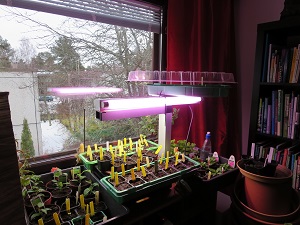
Lähes kaikki tomaatit ovat itäneet, myös ne varasiemenet ja niiden varasiemenet. Eli tomaattia on tulossa runsaasti. Sama juttu elämänlangoilla, varasiementen varasiemenet itäneet. Koulin ne kaikki omiin ruukkuihinsa, helpompi tehdä se nyt kuin sitten kun juuret ovat ihan solmussa. Kylvöt siis tehty 9.2.
Lueskeltuani kelloköynnöksen hoito-ohjeita, päätin ostaa yhden varapussin (huom! ei varasiemenen istutusta, vaan varapussin istutus). Siemeniä oli tasan kymmenen ja pohjalämpö kuulemma kaiken a&o. Joten ne siis muuttivat lampun päälle muhimaan. Kylvö 15.2.
Oikealla näkyy kolme verenpisaraa, jotka olivat humahtaneet niin, että ne piti latvoa. Alwin, Sir Matt Busby ja El Camino.
Almost all my seeds has started to grow, I set three seeds / pot, assuming that only one will grow. Well now I have tomatoes and Ipomoeas. Enough for myself, for my relatives and neighbors. I just read good hint, that in mothers day you can just give (a lot of) gifts.
I wanted to be sure that I will get at least one Cobaea scandens, so I bought one more bag/pouch of seeds (10 seeds). With my luck they all will grow. And without saying, I am still missing the white one. And pink.
My fuchsias has grown so much, that I had to cut three of them Alwin, Sir Matt Busby ja El Camino. So I have three more fuchsias…
***
The genus Cobaea is named after Bernabé Cobo (1582-1657), a Jesuit missionary and naturalist.
Bernabé Cobo lived 61 years in Mexico and South America and much of what we know about the Inca civilization is all due to the writing of this one remarkable Spanish priest.
Arriving in Peru in 1599, he visited the former Inca capital, Cuzco, in 1609 and spent the rest of his life writing a 47 volume “History of the New World,” which he completed in 1653. Cobo recorded much of the information we know about the Inca 100 years after the Spanish conquest; some of these are still in press after some four hundred or more years.
Father Cobo was beyond all doubt the ablest and most thorough student of nature and man in Spanish America during the seventeenth century. Yet, the first, and almost only, acknowledgement of his worth dates from the fourth year of the nineteenth century.
The distinguished Spanish botanist Cavanilles not only paid a handsome tribute of respect to the memory of Father Cobo in an address delivered at the Royal Botanical Gardens of Madrid, in 1804, but he gave the name of Cobæa to a genus of plants belonging to the Polemoniaceae family of Mexico, Cobæa scandens being its most striking representative.
The species name scandens simply means ‘climbing’.
The bell-shaped flowers have a ruff of bracts, hence the common names, Cup and Saucer Vine, Cathedral Bells or Monastery Bells